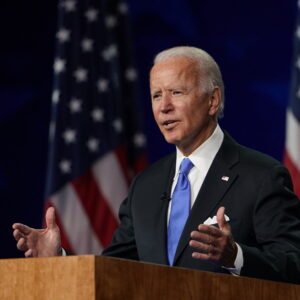Tag: 46th president
Film Review: Prey
by Patrick Smith '26 on October 21, 2022
A&E Staff
Arts & Entertainment
A Thoughtful Reinvention of a Cult Classic
Despite being a cult classic in the genre of slightly campy, ’80s sci-fi action Predator (1987) has always had its challenges with sequels. You would think that making a movie based largely on a handful of very intense people fighting an invisible crab man in an exotic locale would be a relatively straightforward undertaking, but Predator’s offspring have generally remained somewhere on the spectrum of far too goofy to overly dour. Prey (2022) represents a meaningful step forward in this field, as it retains the spirit of the original film while creating its own distinct identity and flavor. It represents a combination of the best elements of what worked in the Schwarzenegger classic with a modern flavor and new take on the subject matter.
The inclusion of Comanche culture and the 1700s American Great Plains as a setting is both Prey’s most immediately striking feature and its greatest design decision. The Comanche culture adds a feeling of uniqueness to the film, as Native Americans are rarely represented in lead roles in large-scale productions, and the significance of hunting within Comanche society ties in well to the themes the franchise is known for. Amber Midthunder gives an excellent performance as the film’s protagonist, Naru. She instills an immense amount of charisma and energy into the role. Thematically, much of the movie takes place during Naru’s ceremonial hunt, which is a nice framing device for the film as it juxtaposes her own hunt against her foe’s. Naru’s skills develop and grow as she learns from her opponent and gauges its strengths and shortcomings. I really enjoyed the period piece elements of the film because they explore an era and people that are not typically represented in this kind of affair and feel substantially differentiated from the heavily militarized commandos of the original.
The film’s cinematography is continuously strikingly beautiful and really encapsulates the feeling of a great, expansive wilderness. The film has a distinctly warm color palette and lovingly captures the feeling of the American wilds, and the fantastic sense of atmosphere and exploration throughout fully immerses the viewer. There’s a particularly well-composed sequence that masterfully uses fog and smoke to create a tense and unnerving atmosphere. The Yautja (the canonical name for the titular species of alien hunters referred to as “Predators”) has been redesigned to appear more naturalistic, sporting a helmet that resembles an animal skull more than the traditional metal mask look. It’s a nice change of pace from the traditional design and works in the context of the film’s period piece elements.
What I would attribute to Prey succeeding where many a Predator sequel has failed is a combination of its tone and use of the original film as a reference. Projects like AVP: Alien vs. Predator and The Predator have been silly and outlandish, while films like Predators have been overly serious and dour. All of these films attempt to up the ante of the Predator status quo, with design choices like upping the number of Yautja, throwing in the Xenomorphs from Alien and its sequels, and generally trying to artificially intensify the film by cramming as much as possible into the final product. Prey opts for a different, more minimalist approach to great effect. The film is largely consistent with the ideas and structure presented in the original film, and simply builds carefully upon its design philosophy. The new setting keeps the film fresh, but it retains much of the original’s charm out of its reverence and understanding of what made it work.
In conclusion, Prey marks the first great Predator sequel through its strong acting, production value, “back to basics” approach, and unique point of view. It’s a real shame that Prey was exiled to Hulu (likely as a casualty of the Disney and 20th Century Fox merger, although that is simply speculation) as it’s one of the strongest and most exciting films to come out this year and deserves to have had a theatrical release.
Welcome, Folks, to the Biden Administration: A Closer Look at the First 100 Days in Office
by The Cowl Editor on February 11, 2021
National and Global News

Photo courtesy of pixnio.com.
by Katherine Morrissey ’22
News Staff
Joseph Biden, Jr., ran a successful campaign grounded on a platform that aligned itself with the Democratic Party’s core beliefs, ultimately resulting in his inauguration as the 46th president of the United States.
The significance of an administration’s first 100 days in office dates back to the incredible feats accomplished by President Franklin D. Roosevelt at the start of his presidency in 1933. In the wake of the Great Depression, Roosevelt inherited a country in economic tatters with nearly a quarter of the nation unemployed following the stock market crash of late 1929. However, Roosevelt did not let the circumstances delay implementing his progressive agenda to help combat the economic and social effects of the Great Depression through the passage of 15 bills.
After being sworn in on Jan. 20, President Biden inherited a United States in a period of distress, much like President Roosevelt did in 1933. However, many would argue that President Biden has perhaps inherited circumstances that are far more unprecedented.
Within the last year, according to the New York Times, over 400,000 Americans have lost their lives during the nation’s struggle to combat the COVID-19 pandemic. Additionally, the pandemic has had detrimental effects on the country’s economic performance.
According to the Bureau of Economic Analysis, the United States experienced two consecutive quarters of decline in gross domestic product, indicative of a recession. Furthermore, it recorded a decrease of 9.1 percent in the second quarter of 2020. This marked the country’s starkest quarterly drop of economic output in recorded history—quarterly GDP has been recorded since 1947 and has never exceeded a drop of more than three percent throughout various recessions.
Given that the nation is faced with such dire circumstances as a result of the ongoing pandemic, a large part of President Biden’s agenda for the beginning of his administration involves taking swift action to combat the ongoing public health and economic crises. While President Biden has made significant promises to combat COVID-19, he also plans to make good on other pledges he made during his campaign regarding other key issues. For example, he has promised to send a bill to Congress which would be for “legislative immigration reform that will modernize our immigration system and give nearly 11 million undocumented immigrants a roadmap to citizenship.”
In regard to the climate and environmental concerns of the country, President Biden promised to sign two executive orders. The first will create a plan to reach a one hundred percent clean energy economy and net-zero emissions by 2050. The next would look “to conserve 30% of America’s lands and waters by 2030.”
On the note of civil rights, President Biden promised to repeal the Trump-era military ban on transgender individuals and restore the protections and provisions of the Obama administration concerning transgender rights.
Additionally, President Biden signed executive orders that included rejoining the Paris Climate Agreement, launching a “100 day mask challenge,” extending student loan pause, launching a Whole-of-Government Initiative to Advance Racial Equity, halting construction of the southern border wall, restoring protection of DREAMers, reversing the Muslim ban, and ensuring worker protections by mandating that employees follow CDC guidelines.
While many frequently criticize Biden for his centrist or moderate beliefs amongst his Democratic constituents, these actions taken on his first day in office actually demonstrate his commitment to following through on a progressive agenda, regardless of the tumultuous times our country is enduring.
Going forward, Americans can expect the Biden Administration to continue to be aggressive in attempting to implement the policies they promised on the campaign trail, as well as in reversing Trump-era policies.
The administration is currently working with Congress to reach a compromise to provide greater economic relief to citizens through another round of stimulus checks.
Although the circumstances are different, the legacy of President Roosevelt’s first 100 days in the Oval Office seems to be shaping the Biden Administration’s approach to office as Biden optimistically attempts to steer the United States out of a historically challenging period and into one of hope and prosperity.
The Painful Transition of Power: Mixed Emotions as New Presidential Administration Takes Office
by The Cowl Editor on February 4, 2021
National and Global News

by Katherine Morrissey ’22
News Staff
On Jan. 20, at 12 p.m., Joseph R. Biden, Jr. was sworn in as the 46th President of the United States. While his inauguration marked the end of President Donald Trump’s four-year term and an unprecedented election cycle, it also came at the end of a historic month of strife and terror.
As legislators joined to officially count and certify electoral votes, a large crowd gathered nearby for what would become one of President Trump’s most memorable rallies. However, what followed on this date would shock the nation to its core.
Around 1 p.m., Americans watched as rioters from the protests began to attack Capitol police as they attempted to enter the Capitol building. Their motive: to delay and stop the certification of the election. Due to concerns about the violent nature of the event, legislators were ordered to shelter and eventually evacuate.
By 2 p.m., the rioters had breached the Capitol by scaling walls, breaking windows, and passing through security with violent force. An hour later, they reached the House Chamber armed with zip ties and cell phones to record their actions. Many videos and photos that rioters took on the Senate floor eventually began circulating the internet and news channels, with some images depicting disturbing symbols of white supremacy.
The Capitol was not secured until after 5 p.m. Following the attack, about 1,100 National Guard troops were mobilized. Congress was able to reconvene by the late evening and eventually certify the remaining electoral votes, but not before five individuals lost their lives in the assault.
Three police officers died in the days immediately following the Capitol riot: Brian Sicknick, who died of injuries sustained during the incident, and Howard Liebengood and Jeffrey Smith, who took their lives after defending the Capitol building on Jan. 6. Their deaths highlight a stark contrast between the attack on Capitol police and the Republican Party, which prided itself on “backing the blue” and supporting law enforcement.
During and following the events at the Capitol, many criticized President Trump’s language and overall delay in response, claiming he did not condemn the actions of those involved, and in some situations, seemed to incite or support it.
During the rally, President Trump continued to assert the false notion that the election results were invalid, stating, “We won this election, and we won it by a landslide.” He continued, “We will stop the steal,” in reference to the election. He also stated, “If you don’t fight like hell, you’re not going to have a country anymore,” which some have considered to be the inflammatory spark that ignited a day of unrest and destruction.
After months of spreading misinformation through social media and then his failure to explicitly condemn the attack, President Trump’s personal Twitter account was permanently deleted by the company.
The attack seemed to come as a continuation of the Trump administration’s refusal to partake in the peaceful transition of power and ultimately accept the results of the 2020 election. President Biden spoke of pain prior to his inauguration in a speech given at a COVID-19 memorial at the reflecting pool in Washington, D.C. He stated, “To heal, we must remember. It’s hard sometimes to remember. But that’s how we heal. It’s important to do that as a nation.”
Many across the nation can resonate with the statement. The inauguration and a new administration will not erase the pain of the tumultuous times felt by the nation, rather, it will continue to remember this pain in order to successfully move forward.
Despite President Trump’s refusal to concede, the violent threats against democracy, and the chaos of a pandemic, the country moved forward on Jan. 20, with the inauguration of Joseph R. Biden as President of the United States.
President Biden, at 78, is now the oldest president to be inaugurated into office. He also serves as the second Catholic president in office, decades after President John F. Kennedy. Kamala Harris became the first female, Black, and South Asian American vice president, demonstrating what a significant and historic moment this day was for the country.
Biden stated in his inaugural address, “This is America’s day. This is democracy’s day. A day of history and hope, of renewal and resolve. Through a crucible for the ages, America has been tested anew. America has risen to the challenge.”
Following a year of unprecedented turmoil, the United States now has the chance to reaffirm its commitments to democratic ideals and to move forward to overcome the challenging nature of these times.
From Scranton, PA to Pennsylvania Avenue: Biden, Harris Enjoy Historic Victory
by The Cowl Editor on November 12, 2020
National and Global News

by Eileen Cooney ’23
News Staff
On Saturday, Nov. 7, after four long days of counting votes from key swing states including Arizona, Georgia, Nevada, North Carolina, and Pennsylvania, presidential candidate Joseph Biden obtained 290 electoral votes, surpassing the 270 threshold needed to take the White House.
Early Friday morning, Joe Biden took the lead in Pennsylvania, a very promising sign for the Biden campaign, as Biden sought to turn the state blue after Hillary Clinton failed to do so in the 2016 presidential election. With Biden winning Pennsylvania and leading in Georgia, President Donald Trump’s hopes at reelection were squashed—without Georgia or Pennsylvania, he could not gain enough electoral votes to win reelection.
In a speech given on Thursday, Nov. 5, President Trump indicated his intentions to preserve the integrity of the election by bringing the results to the courts, saying there would be “a tremendous amount of litigation,” and that he would not “allow anyone the ability to steal such an important election.” He also urged officials to stop counting votes, tweeting “STOP THE COUNT!”
On Nov. 6, Supreme Court Justice Samuel Alito temporarily granted a GOP request to have mail-in ballots received after Nov. 3 in Pennsylvania separated, but he did not prohibit them from being counted.
Many prominent Republican Senators publicly defended President Trump’s claims of election corruption. Senator Lindsey Graham, chair of the Senate Judiciary Committee, was one of many who said that he stands with President Trump. Similarly, Senator Ted Cruz has also affirmed his support for President Trump, voicing his opinion that the Justice Department, state legislatures, and the Supreme Court should get involved to make sure that voting laws have been followed properly. Others, notably Senate Majority Leader Mitch McConnell, have remained largely mute on the subject, with McConnell only tweeting, “Every legal vote should be counted.”
While it was largely expected that a winner would not be determined on election night due to the COVID-19 pandemic and the surge in absentee voting, Democratic leaders and the Biden campaign were not expecting President Trump to declare victory prematurely.
On election night, Trump gave what seemed to be a victory speech, where he claimed victory in Georgia and North Carolina, even though ballots were still being counted. He also contested the results in Arizona, calling upon officials to overturn their decision to give Biden those electoral college votes at the time.
In the days following election night and the pronouncement of Joe Biden as the winner, President Trump has vehemently attacked the integrity of the election, claiming that “if you count the legal votes, I easily win,” and calling mail-in voting “a corrupt system.” He has accused Democrats of trying to steal the election from him, claiming that the voting apparatus of those states key swing “are run in all cases by Democrats.”
This statement is false, as in the key states of Georgia and Nevada, the top elections officials, Secretary Brad Raffensperger and Secretary of State Barbara Cegavske, respectively, are both Republicans. Again, President Trump and his campaign team have publicly announced their intentions to pursue legal action to ensure that all election laws were followed.
Meanwhile, the Biden campaign remains confident in the results of the election, with Joe Biden giving a victory speech that focused on his administration’s next steps and attempted to bridge the divide between Biden and Trump supporters. Biden said, “For all those of you who voted for President Trump, I understand the disappointment tonight. I’ve lost a couple of times myself. But now, let’s give each other a chance.”
Biden also announced on social media, “I am humbled by the trust and confidence you have placed in Kamala Harris and I. We’re reminded tonight of all those who fought so hard for so many years to make this happen. It is long overdue, but once again, America has bent the arc of the moral universe towards justice.” This election will certainly be one for the history books, as Mr. Biden received the most votes ever cast for a U.S. president and Ms. Harris became the first woman, first Black American, and first South Asian American to be elected to the office of vice president.
